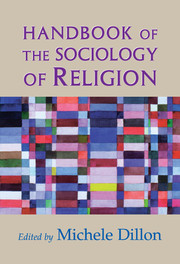Book contents
- Frontmatter
- Contents
- List of Contributors
- Acknowledgment
- Part One Religion as a Field of Sociological Knowledge
- Part Two Religion and Social Change
- Part Three Religion and the Life Course
- Part Four Religion and Social Identity
- 16 Religious Identities and Religious Institutions
- 17 Religion and the New Immigrants
- 18 A Journey of the “Straight Way” or the “Roundabout Path”
- 19 Beyond the Synagogue Walls
- 20 Dis/location
- Part Five Religion, Political Behavior, and Public Culture
- Part Six Religion and Socioeconomic Inequality
- References
- Index
16 - Religious Identities and Religious Institutions
Published online by Cambridge University Press: 05 June 2012
- Frontmatter
- Contents
- List of Contributors
- Acknowledgment
- Part One Religion as a Field of Sociological Knowledge
- Part Two Religion and Social Change
- Part Three Religion and the Life Course
- Part Four Religion and Social Identity
- 16 Religious Identities and Religious Institutions
- 17 Religion and the New Immigrants
- 18 A Journey of the “Straight Way” or the “Roundabout Path”
- 19 Beyond the Synagogue Walls
- 20 Dis/location
- Part Five Religion, Political Behavior, and Public Culture
- Part Six Religion and Socioeconomic Inequality
- References
- Index
Summary
For modern social theory, as well as for many ordinary people, religious identities have been a problem. Just what does it really mean to claim a Jewish or Christian identity? To think of oneself as Presbyterian or Baptist? What do we know of that new church down the road that simply calls itself “Fellowship Church”? And do any of those things have anything to do with how we might expect someone to perform their duties as a citizen or a worker? As modern people have loosened their ties to the families and places that (perhaps) formerly enveloped them in a cocoon of faith (or at least surrounded them with a predictable round of religious activity), they can choose how and whether to be religious, including choosing how central religion will be in their lives. Religious practices and affiliations change over a complicated lifetime, and the array of religious groups in a voluntary society shifts in equally complex ways. If religious identity ever was a given, it certainly is no longer.
In his influential work on religion and personal autonomy, Philip Hammond posits that, given the mobility and complexity of the modern situation, individual religious identities are of various sorts – either ascribed (collectivity-based) or achieved (individual) and either primary (a core or “master” role) or secondary (Hammond 1988). In the premodern situation, religion was presumably collective and core. In the modern situation, taking up a collective, core religious identity is a matter of (exceptional) choice, not determinism.
- Type
- Chapter
- Information
- Handbook of the Sociology of Religion , pp. 207 - 224Publisher: Cambridge University PressPrint publication year: 2003
- 102
- Cited by



